Eating cheap in Laos is easy for backpackers and budget travelers. Eating local food can be slightly more complicated in a country whose cuisine is often a fusion of Laos food and that of its neighbors.
Backpacking is the most common method of travel through Laos. It’s easy to suggest where backpackers should go, as the country has a lot of beautiful scenery and interesting culture to explore. But eating in Laos for backpackers – that is, eating cheap and local food – is a different matter.

Knowing what to expect is the smartest way to travel. That includes food. Not that surprises aren’t fun – there are always plenty of surprises when traveling, even for the most overly-prepared tourists – but having a head’s up can save a lot of headaches (and worry, for those with food allergies) and lead to a better trip.
When it comes to eating cheap and local in Laos, knowing what to expect is a must for food-minded backpackers.
Contents
Eating in Laos: What’s on the Menu?
Let’s start this off by explaining a little about Laos food and regional influences. So, what is Laos food?
Like much of East Asia, eating in Laos (on the most basic, oversimplified level) involves a lot of rice, noodles and fresh vegetables. Chicken is the most common meat, with pork and beef also prevalent. Essentially, from a distance, food in Laos doesn’t look much different than that of it’s neighbors.
Laos is at a crossroads of Southeast Asian influence, and food in the country reflects that. It’s a blend of everything east, west, north and south of the country. There are many dishes that claim to be Lao in origin, but neighboring countries are making the same claim.
Northern Laos has a large Chinese influence. Literally, there are a lot of ethnic Chinese residents and Chinese food. Vietnam’s presence as the neighbor to the east – and, of course, Thailand just across the Mekong River to the west – is evident by the Thai and Vietnamese food found in Vientiane. And Luang Prabang is trying so hard to be a quaint little bubble of colonial French-Laos fusion cuteness, it has forgotten the Lao part.
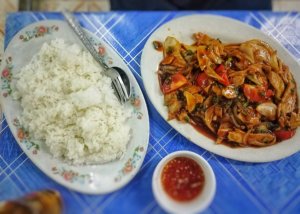
Eating Lao food in Laos is actually kind of a difficult thing to do, especially for independent backpackers. With a local guide, it may be easier to find local food. For independent travelers, even for experienced foodie wanderers, there is little that stands out in the country as uniquely Lao food.
Food is not bad in Laos. In fact, it’s quite the opposite. Lao food is good. Rather, food IN Laos is good. The ingredients are fresh and plentiful, and flavors have a great range of spicy to sweet.
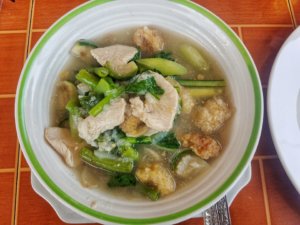
It’s not difficult to find a tasty meal in Laos. And the country has a decent beer to pair with your meal. Like beer in many Southeast Asian countries, the country has a dominant national beer – Beerlao. Beerlao pairs well with the good food steamy temperatures found in the country.
But the difficulty in eating Lao food is finding Lao food. There’s plenty of local restaurants, but many of these are more Vietnamese, Chinese or Thai than anything uniquely Lao.
Below we’ll examine the cost of eating in Laos (and the difficulty of eating cheap) plus eating in five of the most popular destinations in Laos, and what to expect when it comes to eating for backpackers.
Eating on a Budget
Budget travelers and backpackers needn’t worry about breaking the bank over dinner in Laos. Food is incredibly cheap by Western standards. Local restaurants are also very affordable for any budget.
If you stick to locally-owned cafes, unassuming mom-and-pop types, you don’t have to be a nifty backpacker to eat for less than $10 USD per day. As long as you’re not picky. A healthy plate-full of rice or noodles with vegetables and meat can be found with ease for less than $3 USD (as of January 2021, that’s a little less than 30,000 Lao kip). Depending on specifics such as location in Laos and within any particular city, the price can be even less.
If you’re not picky, it’s easy to eat cheap in Laos. Of course, as soon as you order an appetizer or two and wash it down with a few Beerlao, the bill grows.
For the most part, expensive food in Laos is limited to foreign cuisine, i.e. not Southeast Asian. Or the old town of Luang Prabang. For instance, if you want to eat pizza, it’s going to cost significantly more than local food. Even Indian food or shwarma, normally among the cheapest options, are a little more expensive than your neighborhood cafes.
Luang Prabang
Luang Prabang is a very touristy city. Located in mountainous northern Laos, the city is the most popular tourist destination in Laos.
The popularity is obvious, as the old Town of Luang Prabang is very well preserved. Known for its French colonial architecture, historical significance and Buddhist monasteries, it’s easy to understand why Luang Prabang attracts so many visitors.
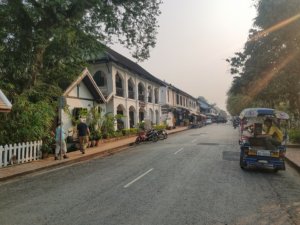
With the popularity came an interesting culinary scene. The French influence and international interest created a variety of food unlike any other in Laos. But where does Luang Prabang fit in the analysis of eating in Laos for backpackers?
That is a different story. Food in Luang Prabang gets a lot of hype. Most of the restaurants with high ratings are not backpacker friendly. The notion that Luang Prabang is a destination for culinary tourism is based on food that is, in essence, not local.
Family-run local businesses are overlooked in favor of expensive, pretty food from ethics-touting restaurants.
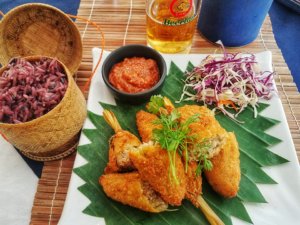
Food at these morally-superior restaurants is hit or miss. There’s a chance that expensive meal is not good. But, hey, at least it makes a pretty picture, right? (note: sarcasm)
“Worst of all, the notable eateries in Luang Prabang lack a certain level of authentic eating, with little on the menu that represents Laos, leaving backpackers hangry for more.
Why travel thousands of miles around the world to eat fancy, overpriced fusion cuisine?”
For more: Eating in Luang Prabang.
The Luang Prabang Night Market is the best source of cheap food in town. The market is organized with tourists in mind, but it is undoubtedly the best place to find local food. For backpackers eating on a budget in Laos, the Luang Prabang Night Market stands above all other options.
Vientiane
Vientiane is a strange city. The busy city with a population just under one million people brings in a fair amount of tourists, mainly owing to its position as the national capital. There is a smattering of important temples and monuments, but nothing that warrants a visit to Vientiane in its own right.
Few backpackers rave about time spent in Vientiane. Rather, it is more commonly viewed as nothing more than a stopping point. Personally, I found Vientiane to be a very hot, very interesting place. A day or two to visit is adequate and even enjoyable, but there’s something missing.

As far as eating in the capital of Laos – eating local and on a budget – Vientiane is not a city to visit for food alone. There is a huge variety of options, ranging from local cuisine to Indian food to Dairy Queen. Fortunately, without the massive tourism presence like that found in Luang Prabang, food in Vientiane is cheap. But the local food scene is largely underwhelming.
Navigating food in Vientiane is difficult. There are plenty of restaurants, but finding something local in the mix of international options is a challenge. Personally, I suggest finding a local guide to lead you to the best food in Vientiane.

Night markets are popular with locals and are a good place for cheap and interesting food.
For the tastiest food in Vientiane, find a local Thai or Vietnamese restaurant. Since there is very little true Lao cuisine, Vientiane is a great place to try Lao versions of Thai and Vietnamese food. Lao cooks are more than capable, and this is evident in Vientiane’s variety of restaurants despite the frustrations of trying to find local cuisine.
Four Thousand Islands
Si Phan Don, more commonly known as Four Thousand Islands, is one of the coolest and most laid-back places in Southeast Asia. The islands sit in the middle of the Mekong River in southern Laos. Don Det and Don Khong are the primary island destinations for most travelers.
Most backpackers crossing into southern Laos head to Four Thousand Islands to relax for a few days, with little care of eating anything authentic. That’s a good mentality to have here. The remote nature of Four Thousand Islands – the islands are only accessible by worn out longtail boats, and there are no real roads – limits transport of goods.


The limitations on transportation and imports results in simpler menus. There are still Lao specialties served, but most menus are a combination of general Southeast Asian food. Travelers will see various rice and noodle dishes, along with plenty of fried options. Meat is typically chicken and pork, although beef is available, too.
Surprisingly, despite being located in the middle of a large river, there are few fish options. Perhaps this says something about overfishing or the cleanliness of the water. Either way, Four Thousand Islands is not a destination for food.

The most important thing for backpackers to consider when eating in Four Thousand Islands is the higher prices than most destinations in Laos. The remoteness and limited options for food is a simple case of supply and demand. However, higher prices for Laos does not mean expensive. You can still eat on $10 a day relatively easily.
Food is good in Si Phan Don, but there is nothing astonishingly cheap or uniquely noteworthy. The 4000 Islands are unquestionably one of the most spectacular natural sites in Southeast Asia. It is worth the tedious trip here to experience the beauty. Just don’t expect dinner to be as spectacular as the roaring waters of the Mekong River.
Vang Vieng
Vang Vieng is a rapidly changing city. A few years ago, it was known as a drunken city of drugs and wild parties. After some bad press – and a string of unfortunate, albeit avoidable tourist deaths – the government stepped in and shut down the party.
Today, Vang Vieng is still a popular destination in Laos, but backpackers have largely been replaced with Chinese and Korean tour groups. The focus of travel is now on the surrounding natural landscape, with partying taking a backseat.
Although backpackers are no longer the primary tourists in Vang Vieng, eating in the city remains as one of the best in Laos.
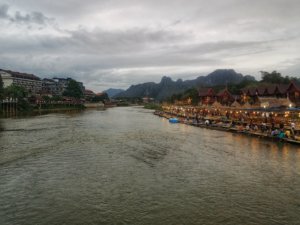
The most popular eating in Vang Vieng takes place along the Nam Song River. The east bank is lined with pricey hotels and equally pricey restaurants. Along the western bank, locals set up chairs, tables and large grills. Diners walk up and have their pick of food to be grilled and then take a seat. The setting is a perfect way to enjoy an evening in Vang Vieng.
The highest concentration of restaurants and budget friendly eating, the kind backpackers thrive on, is away from the river. There are hundreds of restaurants in a small area of Vang Vieng. The expensive choices stand out – you can’t miss the large signs and seating for a hundred guests. Otherwise, have your pick of local restaurants, and enjoy a large spread for a very reasonable price.
Phonsavan & the Plain of Jars
The only reason for most travelers to venture to Northeastern Laos is the mysterious site of the Plain of Jars. Laos’ Plain of Jars is an ancient site shrouded in mystery. These giant stone “jars” date back thousands of years and are the subject of a variety of anthropological theories and fun local legends.
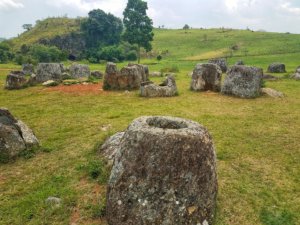
Phonsavan is the nearest city and the center of interest concerning the Plain of Jars. Eating in Phonsavan is not the easiest of places for backpackers in Laos. Strangely, in a remote area of Laos that is otherwise extremely rural and highly agricultural, eating is not very cheap (by local standards). Not that you cannot find cheap food, but considering the setting, food is overpriced.

The local restaurants in Phonsavan are flat. Lao food is not remarkable to begin with, but the food in Phonsavan is about as exciting as the Plain of Jars (see more on the UNESCO site).
Phonsavan does have a great market with interesting local goods and eats. In fact, the Phonsavan Market is one of my favorites to which I’ve ever been. It’s a glimmer of hope into the local cuisine that is so difficult to find for tourists. The market is also cheap, but it is NOT a clean place. Hangry backpackers beware.
Eating in Laos for Backpackers
One of my initial conclusions while traveling in Laos was that the food was just not that good. Eating cheap in Laos is easy. As far as food is concerned, it won’t be the breaker of backpacker budgets, but finding local cuisine is frustrating.
Having had the chance to reflect on all of the meals and bites I consumed (yes, I note and record everything when it comes to travel and food), it’s not that Laos doesn’t have good food. Laos lacks a local culinary identity.

This is the difficult part of eating in Laos for backpackers. Many backpackers strive to entrench themselves in local settings in hopes for the most authentic travel experience. It is hard to feel like an experience is authentic when the local food is nearly identical to cuisine served in neighboring countries. What Laos lacks in culinary identity, it makes up for as an easy budget eating destination for backpackers.
Laos has great food. And local food is available, but food-focused wanderers need to temper expectations, exercise patience and, of course, wander.
Leave a Reply
You must be logged in to post a comment.